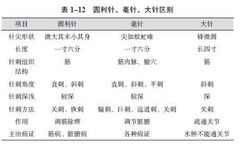The skin, flesh, tendons, bones, and vessels are the primary structural components of the human body and are the bearers of Nine Needles therapy. The Nine Needles regulate the body through acupuncture of these five components, and there exists a correspondence between the Nine Needles and the five components. Since the five components belong to the organs, there is also a correspondence between the Nine Needles and the organs through the five components.
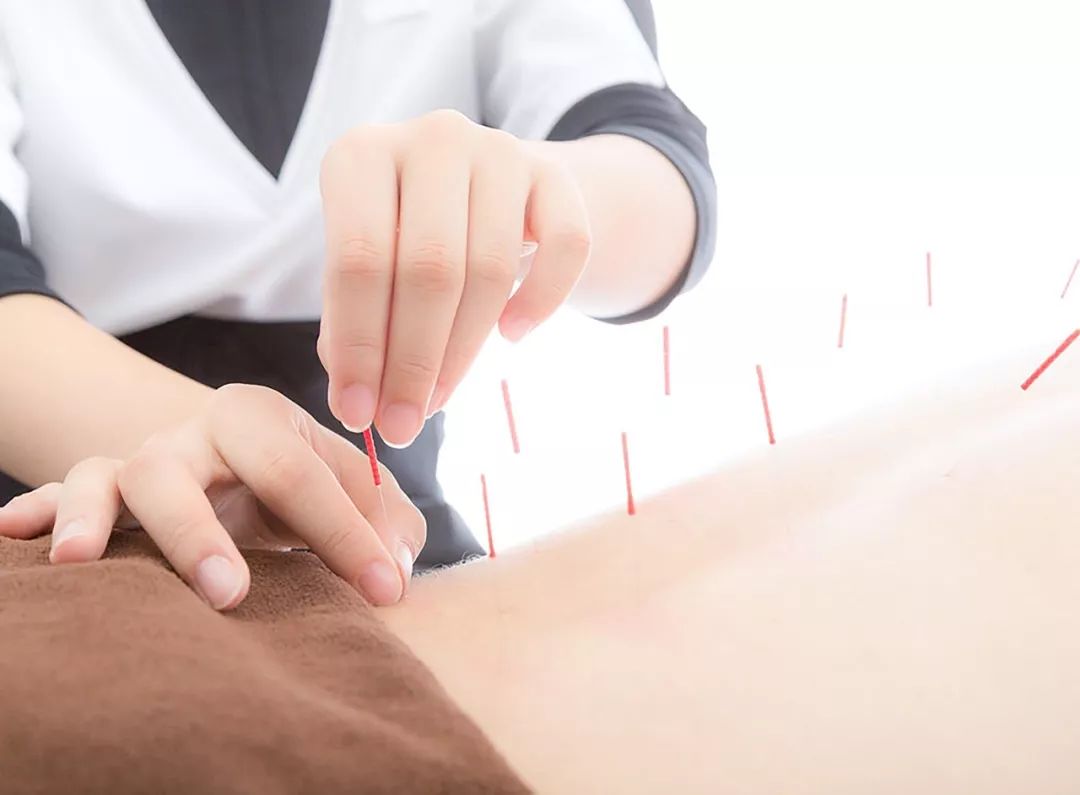
The correspondence between the Nine Needles, the five components, and the organs is as follows:
1. Chai Needle corresponds to the skin and lung diseases
The Chai Needle corresponds to the skin, and the skin is associated with the lung. The Chai Needle punctures the skin to treat skin and lung-related conditions.
2. Round Needle and Hao Needle correspond to muscle and spleen diseases
The Round Needle corresponds to the muscles, which are associated with the spleen. The Round Needle punctures the flesh to treat muscle and spleen-related conditions. In areas where the muscles are thick, the Round Needle can easily damage the muscle, while the Hao Needle is finer and less damaging, making it suitable for treating muscle and spleen-related conditions.
3. Lei Needle, Feng Needle, and Bi Needle correspond to vessels and heart diseases
All three correspond to vessel and heart diseases, but there are significant differences among them (Table 1-11).
(1) Lei Needle corresponds to the vessels, which are associated with the heart. The Lei Needle punctures the vessels to treat vessel and heart-related conditions.
(2) Feng Needle can puncture the meridians to release blood stasis and eliminate heat evil. The heart governs the blood vessels and is associated with fire. The Feng Needle is used on the meridians to treat blood stasis, heat evil, and heart diseases.
(3) Bi Needle is designed for abscesses and heat. The “Lingshu: Official Needles” states: “For large abscesses, use the Bi Needle.” The “Suwen: The Great Discussion on True Essentials” states: “All heat-related conditions belong to fire. All pain, itching, and sores belong to the heart.” Heat also belongs to the heart, and the Bi Needle punctures abscesses to treat heart fire heat toxicity.
4. Round Li Needle, Hao Needle, and Da Needle correspond to tendons and liver diseases
All three correspond to tendon and liver diseases, but there are significant differences among them (Table 1-12).
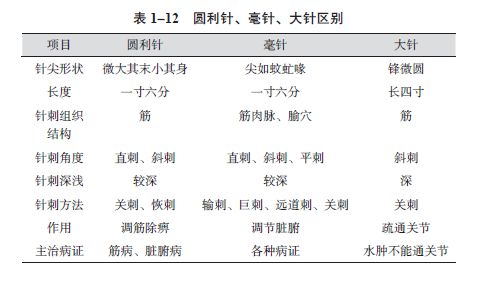
(1) Round Li Needle treats tendons, which are associated with the liver. The Round Li Needle punctures the tendons to treat tendon and liver-related conditions.
(2) Hao Needle primarily treats bi syndrome pain and numbness, which are tendon-related conditions. The “Lingshu: Official Needles” states: “For bi syndrome with qi pain that does not go away, use the Hao Needle.” The “Lingshu: Discussion on Nine Needles” states: “The seventh is the Hao Needle, modeled after fine hair, measuring one inch and six tenths, primarily for cold, heat, and pain in the collaterals.” The Hao Needle is often used to treat tendon-related conditions and various other diseases.
(3) Da Needle is used to unblock joints, and joint swelling is a tendon-related condition. The “Lingshu: Official Needles” states: “For water swelling that cannot unblock the joints, use the Da Needle.” The “Lingshu: Nine Needles and Twelve Originals” states: “The Da Needle is sharp like a stick, with a slightly rounded tip, used to drain water from the joints.” The Da Needle primarily treats tendon diseases, particularly “water swelling that cannot unblock the joints.”
5. Chang Needle and Feng Needle correspond to bones and kidney diseases
The Chang Needle treats bones, which are associated with the kidneys. The Chang Needle punctures the bones to treat bone, kidney, and chronic diseases. The Feng Needle can also puncture bones to treat bone, kidney, and chronic diseases.
This is the basic correspondence. Since the human body is an organic whole, interconnected, the Nine Needles, five components, and organs also have multiple correspondences. For example, the Chai Needle puncturing the skin can also treat heart, liver, spleen, and kidney diseases; the Round Needle puncturing the flesh can also treat tendon and other organ diseases; the Hao Needle treating tendons can also treat heart, lung, spleen, kidney, and skin conditions; the Feng Needle puncturing the vessels can treat meridian and organ diseases; the Chang Needle puncturing the bones can treat organ diseases and difficult conditions.
The Nine Needles can treat diseases individually, but they often work in collaboration. For instance, the Chai, Round, and Da Needles may require the Feng Needle to open the skin before insertion. In treatment, sometimes a single needle is used for a condition, but more often, one needle is primary while multiple needles are used in conjunction.
For the same area, using different needles and techniques can treat different conditions. For example, for heat diseases at fifty-nine points, the Chai Needle treats heat diseases first affecting the skin, nasal obstruction, and facial fullness, while heat diseases first affecting the body cause stiffness, heat, agitation, and dry lips and throat. The Round Li Needle treats heat diseases with dry throat, excessive thirst, restlessness, and inability to rise from bed. The Feng Needle treats heat diseases with heavy body, bone pain, deafness, and preference for sleep.
This article is excerpted from “The Nine Needles Therapy of the Huangdi Neijing”
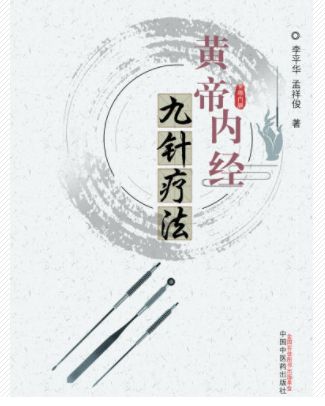
Content Introduction
This book introduces the concept, functions, techniques, acupuncture structure, treatment principles, efficacy standards, treatment conditions, and precautions of the Nine Needles. It discusses the Chai Needle, Round Needle, Lei Needle, Feng Needle, Bi Needle, Round Li Needle, Hao Needle, Chang Needle, and Da Needle from the perspectives of overview, functions, acupuncture structure, indications, and techniques, and introduces 55 conditions from the perspectives of overview, etiology, diagnosis, differential diagnosis, and treatment. This book is a result of our repeated study of the original text of the “Neijing,” aiming to restore the original appearance of the Nine Needles and their techniques, summarizing and enhancing them, and applying them clinically with good efficacy, showcasing the magic of the Nine Needles, which is well-received by patients. It serves as a practical reference book suitable for professionals in acupuncture, orthopedics, rehabilitation, and massage.
Author Introduction
Li Pinghua, male, Han nationality, born in September 1963, from Juye County, Shandong Province, graduated from Shandong University of Traditional Chinese Medicine, chief physician, member of the Shandong Provincial Political Consultative Conference. He has served as the director of the acupuncture department and deputy director of Juye County Traditional Chinese Medicine Hospital, and vice chairman of Juye County Political Consultative Conference. He has been engaged in acupuncture treatment and research for over 30 years, with excellent medical skills, using acupuncture, the Nine Needles of the Neijing, small needle knife, floating needle, scalp needle, fire needle, etc., to treat neck, shoulder, waist, and leg pain with significant efficacy. He is the inventor of the small Zhou Tian method and the five-component acupuncture method, and has authored and published works such as “Acupuncture Points Therapy,” “Returning to the Meridian Pharmacology,” “Small Zhou Tian Micro Bi Needle Therapy,” “Neijing Acupuncture Techniques – Five Component Acupuncture Therapy,” “Frozen Shoulder,” “Non-surgical Treatment of Lumbar Disc Herniation,” “Cervical Spondylosis,” “Non-surgical Treatment of Knee Osteoarthritis,” “Facial Paralysis,” “Conservative Treatment of Avascular Necrosis of the Femoral Head,” and “Grassroots Medical Practice,” among others. His work on “Frozen Shoulder” has been reprinted five times, and the first edition in 1995 established the diagnostic criteria for frozen shoulder nationwide. His work on “Cervical Spondylosis” has been reprinted three times, and his works on “Non-surgical Treatment of Lumbar Disc Herniation” and “Non-surgical Treatment of Knee Osteoarthritis” have been reprinted twice. He has published over 30 papers in provincial and national academic journals. From 1992 to 1993, he served as a Chinese medicine expert in Russia. He has received honors such as the second-class merit from the Shandong Provincial Government and one of the top ten outstanding youths in Heze District.
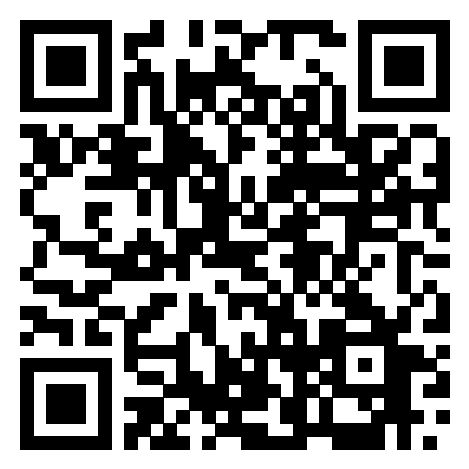
(To purchase the book, you can scan the code or click to read the original text)
END
Copyright Statement
This article is excerpted from “The Nine Needles Therapy of the Huangdi Neijing,” authors: Li Pinghua, Meng Xiangjun. Please indicate the source when reprinting. Cover images and images in the text are from the licensed image library of Shetu Network. Editor WeChat ID: congcong-0423, welcome to submit and chat.

● Master of Traditional Chinese Medicine Li Shizhen, there is so much to uncover…
● If I had known these two formulas earlier, I wouldn’t have developed chronic bronchitis.
If you find this useful, please like it!

